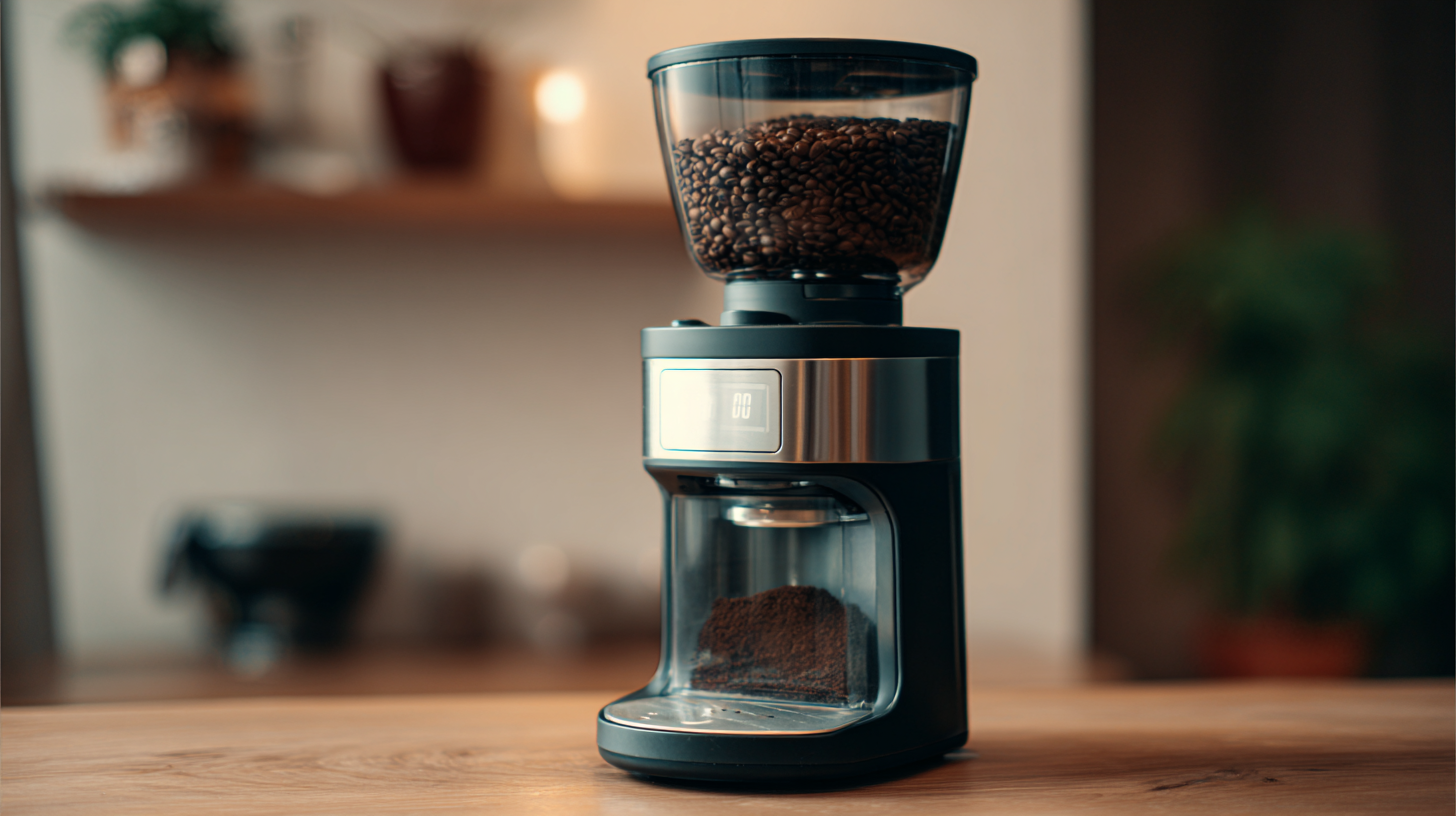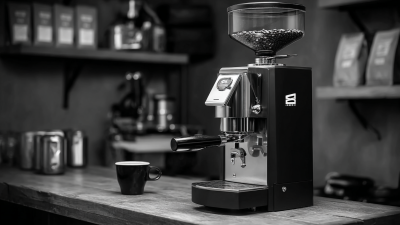Leave Your Message
-
Phone
-
E-mail
-
Whatsapp
-
Whatsapp


Choosing the right Espresso Bean Grinder is a crucial step in unlocking the full potential of your coffee experience. According to renowned coffee expert James Hoffmann, "The grinder is the most important piece of equipment in a coffee brewing setup." This statement emphasizes that the quality of your espresso largely depends on how well your beans are ground. With a myriad of options available, selecting the perfect grinder can feel overwhelming.

In this article, we'll explore ten essential tips to guide you in choosing the ideal Espresso Bean Grinder tailored to your coffee needs. From understanding the different types of grinders to evaluating grind consistency and quality, these insights will ensure that you make an informed decision. You'll learn how to balance your budget with the features that matter most, ultimately enhancing your coffee brewing journey and savoring the rich flavors of your espresso. Whether you’re a casual drinker or a passionate aficionado, finding the right Espresso Bean Grinder is key to achieving that perfect cup of coffee every time.
When selecting the ideal espresso bean grinder for home use, it's crucial to understand the different types available on the market. Primarily, there are two categories: blade grinders and burr grinders. Blade grinders employ sharp blades that chop the beans unevenly, which can lead to inconsistent grind sizes and ultimately affect the flavor profile of your espresso. In contrast, burr grinders use two revolving surfaces (the burrs) to crush the beans uniformly, providing a much more consistent grind. According to the Specialty Coffee Association, a consistent grind is vital for espresso preparation, as it can enhance extraction and improve the overall cup quality.
Furthermore, within burr grinders, consumers face a choice between flat and conical burrs. Flat burr grinders often deliver a more precise grind size, making them suitable for espresso enthusiasts who prioritize consistency. Meanwhile, conical burr grinders are known for their versatility and lower retention of coffee grounds, which can be advantageous for those who enjoy experimenting with various brewing methods. A report from the National Coffee Association indicates that over 60% of coffee drinkers prefer grinding their beans fresh at home, underscoring the importance of selecting the right grinder type to elevate your espresso experience.
When selecting an espresso bean grinder, paying attention to key features is essential for achieving the perfect cup of coffee. First and foremost, grind consistency is crucial. Look for a grinder with a high-quality burr mechanism rather than a blade grinder, as burr grinders provide a uniform grind size, which is vital for extracting the rich flavors of espresso. Additionally, adjustable grind settings allow you to customize the coarseness of the beans, enabling you to experiment with different brewing methods and taste profiles.
Another important feature is the build quality of the grinder. A sturdy, well-constructed machine will ensure durability and stability during grinding. Consider grinders with a powerful motor and heat-resistant materials, which prevent the beans from overheating and losing flavor. Finally, ease of cleaning is often overlooked but is vital for maintaining the grinder's performance. Models with removable parts or easy access to the grinding chamber make maintenance straightforward, ensuring your grinder stays in top condition for the best possible espresso experience.
| Feature | Description | Importance |
|---|---|---|
| Grind Size Settings | Multiple settings to customize grind texture. | High |
| Burr Type | Flat burrs vs. conical burrs for consistency. | High |
| Build Quality | Durable materials for longevity. | Medium |
| Speed Control | Adjustable speed for optimal grinding. | High |
| Portability | Lightweight for easy transport. | Medium |
| Noise Level | Quiet operation for home use. | Low |
| Capacity | Bean hopper size affects grinding frequency. | Medium |
| Price Range | Variety based on features and performance. | High |
| Ease of Cleaning | Design for easy disassembly and maintenance. | Medium |
| Warranty | Coverage period assures product reliability. | High |
When it comes to brewing the perfect espresso, grind size consistency plays a crucial role in the extraction process. According to a report by the Specialty Coffee Association, the ideal grind size for espresso falls within the range of 200 to 400 microns, which allows for optimal flavor release. Variability in grind size can lead to a disparity in extraction, resulting in a shot that is either over-extracted and bitter or under-extracted and sour. This underscores the importance of choosing a high-quality grinder that can deliver uniform coffee grounds.
Research indicates that even slight fluctuations in grind consistency can impact brewing results significantly. A study published in the Journal of Food Science revealed that espresso brewed from inconsistent grind sizes resulted in a 20% variance in total dissolved solids (TDS), affecting the richness and body of the espresso. Hence, investing in a grinder with adjustable settings and burr design can ensure that you achieve the precise grind required for your espresso machine, ultimately enhancing your coffee experience. The right grinder not only simplifies your brewing ritual but also manifests the full potential of the coffee beans you choose.
When choosing the perfect espresso grinder, one of the primary considerations is whether to go for a manual or electric model. Manual grinders are often praised for their simplicity and the control they offer over the grinding process. They can enhance the ritual of making coffee, allowing users to appreciate the sights and sounds of grinding their beans. Additionally, manual grinders are typically more compact and lighter, making them easier to transport for those who enjoy coffee on the go. However, they require more effort and time, which can be a downside for those seeking convenience.

On the other hand, electric grinders provide speed and efficiency, handling the grinding process with minimal user input. Many electric models come equipped with various grind settings, enabling precise customization for different brewing methods. Recent tests have demonstrated that some electric grinders can achieve superior consistency in grind size, which is crucial for brewing high-quality espresso. However, they usually come at a higher price point and can take up more counter space. Ultimately, the choice between manual and electric grinders depends on personal preferences regarding convenience, control, and space.
When it comes to choosing the perfect espresso grinder, budget considerations play a crucial role. While investing in a high-quality burr grinder can significantly enhance your coffee experience, it's essential to find one that aligns with your financial limits without compromising on performance. Recent reports indicate that even budget-friendly options can deliver exceptional results; many grinders priced under $50 still provide an admirable grind consistency suitable for brewing espresso.

In 2025, several models were tested, revealing that the right budget grinder can compete remarkably with high-end variants. With features such as adjustable grind settings and user-friendly designs, some of the lower-priced grinders have proven capable of producing café-quality espresso. Coffee enthusiasts are increasingly emphasizing that a suitable grinder is the key to extracting the best flavors from premium espresso beans, making it a worthwhile investment even for those on a tighter budget.






